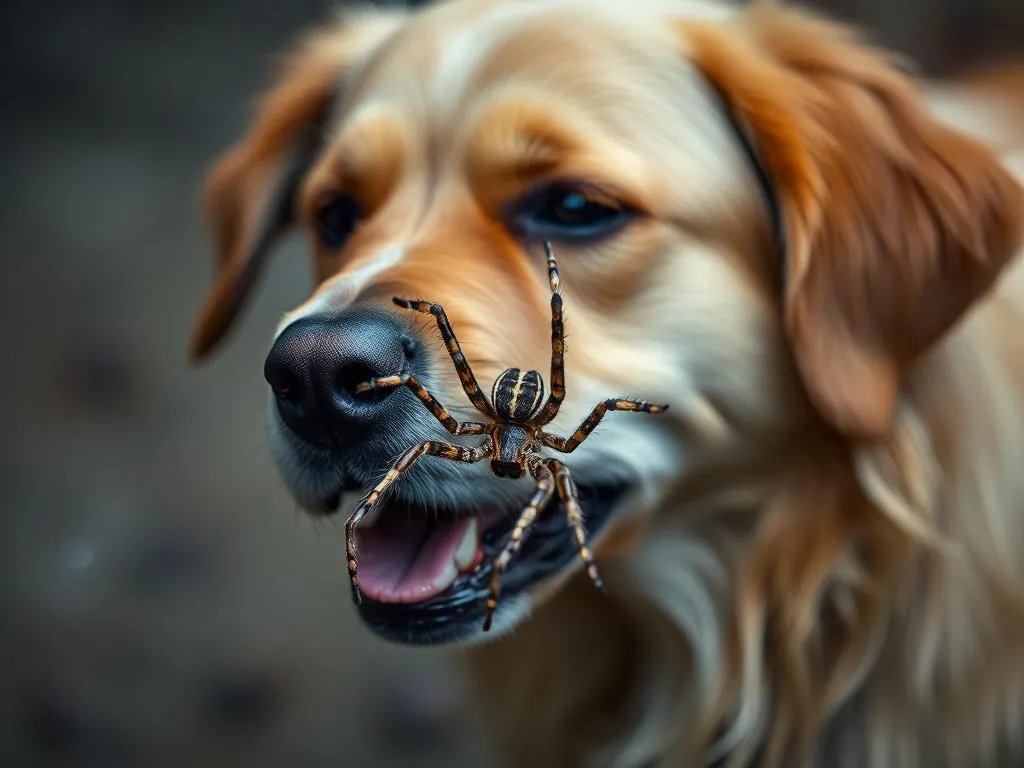
When it comes to our beloved pets, ensuring their health is a top priority. One common concern that dog owners may encounter is: my dog ate a spider. While this might sound alarming, understanding the implications and how to respond appropriately is crucial for your dog’s wellbeing.
Many pet owners might not realize that spiders can pose both minor and significant risks to dogs. This article will provide insights into what to do if your dog eats a spider, potential risks associated with spider consumption, and general health care tips to keep your canine companion safe and healthy.
Understanding Spider Consumption in Dogs
Common Types of Spiders
Spiders are common inhabitants of homes and gardens. The most frequently encountered species include:
- House Spider: Typically harmless and found in corners and crevices.
- Jumping Spider: Small and not venomous, they are more curious than harmful.
- Wolf Spider: A bit larger, but they are also generally non-toxic.
- Black Widow: Recognizable by their shiny black bodies and red hourglass marking, these spiders are venomous.
- Brown Recluse: Light brown with a distinctive violin-shaped marking, also venomous.
It’s essential to identify which spiders are in your home. Most spiders are not dangerous to dogs, but some, like the Black Widow and Brown Recluse, can be harmful if ingested or bitten.
Why Dogs Might Eat Spiders
Dogs are naturally curious creatures. They explore the world around them with their mouths, often leading them to consume unexpected items, including spiders. Here are a few reasons why your dog may eat a spider:
- Natural Curiosity: Dogs have a keen interest in their environment and may see a spider as a moving object to chase.
- Hunting Instincts: Many dogs retain their predatory instincts, viewing smaller creatures as prey.
- Boredom or Playfulness: Dogs left alone for extended periods may engage in play that leads to consuming non-food items.
Symptoms of Potential Issues
After your dog consumes a spider, be vigilant for any unusual signs or symptoms. Some common symptoms to monitor include:
- Vomiting: If your dog starts to vomit, it may indicate gastrointestinal distress.
- Diarrhea: Loose stools can be a sign of irritation in the digestive tract.
- Lethargy: A sudden lack of energy may signal a more serious issue.
- Signs of Pain or Distress: Whining, restlessness, or unusual behavior may indicate discomfort.
It’s important to observe your dog closely for any of these symptoms after spider consumption.
Potential Risks of Dogs Eating Spiders
Toxic Spiders and Their Effects
While most spiders are harmless, some can pose a significant risk to dogs. Here’s a detailed look at venomous spiders:
- Black Widow: Bites can cause severe pain, muscle spasms, and even paralysis. Symptoms may include swelling, excessive salivation, and difficulty breathing.
- Brown Recluse: Their bites can lead to necrotizing skin lesions and systemic reactions. Symptoms often include pain at the bite site, fever, and chills.
If you suspect your dog has been bitten by either of these spiders, immediate veterinary care is essential.
Allergic Reactions
Like humans, dogs can have allergic reactions to spider bites, even from non-toxic species. Signs of an allergic reaction may include:
- Hives or Rash: Red, raised bumps on the skin.
- Swelling: Particularly around the face, ears, or paws.
- Difficulty Breathing: Rapid or labored breathing can indicate a serious reaction.
If you notice any of these symptoms, it’s important to contact a veterinarian promptly.
General Health Risks
In addition to the risks associated with toxic spiders, there are other potential health concerns to be aware of:
- Gastrointestinal Blockages: Ingesting a spider, especially if it’s large, might cause a blockage in your dog’s digestive system.
- Gastrointestinal Irritations: Even non-toxic spiders can irritate the gastrointestinal tract, causing discomfort or distress.
- Secondary Infections: If a spider bite occurs, there’s a risk of secondary infections, especially if the bite site is not monitored or treated properly.
What to Do If Your Dog Ate a Spider
Immediate Steps to Take
If you find yourself in the situation where my dog ate a spider, here are the immediate steps to consider:
- Stay Calm: Your reaction can influence your dog’s behavior. Remaining calm helps prevent further stress.
- Assess the Situation: Determine if the spider was venomous or if your dog is showing any concerning symptoms.
- Contact a Veterinarian: Provide your veterinarian with detailed information, including what type of spider was eaten, the size of your dog, and any observed symptoms.
Home Remedies and Monitoring
If your dog exhibits mild symptoms, there are some home remedies you can try while monitoring their condition:
- Hydration: Ensure your dog has access to fresh water to help flush any irritants from their system.
- Bland Diet: If your dog is vomiting or has diarrhea, consider offering a bland diet of boiled chicken and rice until symptoms improve.
- Monitor Behavior: Keep an eye on your dog for any worsening symptoms or new developments.
When to Seek Emergency Care
Certain red flags indicate the need for immediate veterinary attention:
- Severe Vomiting or Diarrhea: Continuous vomiting or diarrhea can lead to dehydration quickly.
- Unresponsive Behavior: If your dog becomes lethargic or unresponsive, seek help immediately.
- Signs of Pain: If your dog is whimpering or showing signs of distress, it may require urgent care.
Prepare for your vet visit by bringing along any information about the spider or potential symptoms your dog is exhibiting.
Preventing Spider Consumption
Keeping Your Home Spider-Free
Preventing your dog from consuming spiders starts with minimizing their presence in your home. Here are some effective tips:
- Regular Cleaning: Sweep and vacuum corners and under furniture to remove spider webs and eggs.
- Seal Cracks and Gaps: Inspect doors, windows, and walls for cracks where spiders could enter and seal them.
- Natural Deterrents: Use essential oils like peppermint or vinegar, which can help repel spiders without harming your pets.
Training Your Dog
Training your dog to avoid eating non-food items can be beneficial. Consider the following strategies:
- Basic Commands: Teaching commands like “leave it” can help prevent your dog from consuming unwanted items.
- Interactive Toys: Provide engaging toys to keep your dog entertained and reduce the likelihood of them hunting down spiders.
- Redirecting Behavior: If your dog shows interest in a spider, redirect their attention to a toy or treat instead.
Regular Health Check-ups
Routine veterinary visits are essential for maintaining your dog’s health and ensuring they are free from parasites and diseases. Regular check-ups can also help identify any potential issues related to spider bites or other health risks.
- Vaccinations: Ensure your dog is up-to-date on vaccinations to protect against common diseases.
- Preventive Care: Discuss preventive measures with your vet, including flea and tick control, which can also reduce spider encounters.
General Dog Health Care Tips
Nutrition and Diet
A balanced diet is fundamental for your dog’s overall health. Ensure your dog receives:
- High-Quality Proteins: Essential for muscle development and energy.
- Fruits and Vegetables: Provide vitamins and antioxidants that support the immune system.
- Adequate Hydration: Fresh water should always be available to keep your dog hydrated.
Regular Exercise
Physical activity is crucial for a dog’s mental and physical health. Benefits of regular exercise include:
- Weight Management: Helps prevent obesity, which can lead to various health issues.
- Behavioral Improvement: A well-exercised dog is less likely to engage in destructive behavior.
- Bonding Time: Exercise activities like walking or playing fetch strengthen the bond between you and your dog.
Grooming and Hygiene
Regular grooming not only keeps your dog looking great but also helps in preventing health issues. Here are some grooming tips:
- Frequent Brushing: Reduces shedding and prevents matting, which can lead to skin problems.
- Bathing: Regular baths keep your dog’s coat clean and free from pests.
- Ear and Teeth Care: Regular checks and cleanings can prevent infections and dental issues.
Conclusion
In summary, if you find yourself facing the concern of my dog ate a spider, remember that while it can be alarming, understanding the potential risks and knowing how to respond can help keep your furry friend safe. Monitor your dog for symptoms, seek veterinary advice when necessary, and take preventive measures to minimize spider encounters.
Vigilance and proactive care are crucial in maintaining your dog’s health. Whenever in doubt, don’t hesitate to consult your veterinarian for guidance tailored to your pet’s specific needs.
FAQs
What should I do if my dog ate a spider?
Monitor for symptoms and contact your veterinarian if you notice any concerning signs.
Are all spiders toxic to dogs?
No, most spiders are harmless, but some, like the Black Widow and Brown Recluse, can be dangerous.
How can I prevent my dog from eating spiders?
Regular cleaning, training, and providing engaging toys can help reduce the likelihood of spider consumption.
What are the signs of a spider bite in dogs?
Signs may include swelling, pain at the bite site, vomiting, and difficulty breathing.
Is it safe to use pest control around dogs?
Always consult your veterinarian about safe pest control options that will not harm your dog.









